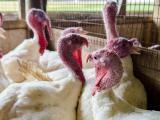In the latest avian flu developments, two more countries in the Middle East—Iraq and Afghanistan—reported highly pathogenic H5 outbreaks, and Germany reported its first H5N6 detection, according to separate reports from the World Organization for Animal Health (OIE).
Elsewhere, Bangladesh reported another outbreak involving H5N1, and South Africa recently detected H5N8 again, this time in a wild bird.
Middle East battles H5
The outbreaks in Iraq and Afghanistan come as Saudi Arabia continues its battle against the rapidly spreading H5N8 strain.
In Iraq, an outbreak involving a commercial poultry farm in Diyala province began on Dec 27, killing 7,250 of 43,000 birds. The remaining ones were culled to control the spread of the virus, the OIE reported yesterday. Diyala province is in the central part of the country.
The event is Iraq's first H5N8 outbreak since October 2016.
In other developments, Afghanistan's livestock ministry said testing on rooks that flew out of a forest near the city of Khost and died revealed highly pathogenic H5. Khost is in eastern Afghanistan on the border with Pakistan.
Rooks are members of the raven family. Of 17 birds found in the outbreak, 14 died, and 3 others were destroyed as part of the response.
In its report to the OIE, Afghanistan said the outbreak is its first since 2007.
Meanwhile, Saudi Arabia reported 16 more H5N8 outbreaks in its ongoing battle against the virus, according to government reports from Jan 7 through today translated and posted by Avian Flu Diary (AFD), an infectious disease news message board. Outbreak locations appear to include Dhurma governorate in Riyadh province, Al Ahsa and Al Kharj governorates, and Howtat Bani Tamim, a town near Riyadh.
H5N6 for first time in Germany
German veterinary officials said highly pathogenic H5N6 has been detected in a wild duck found dead on Jan 4 near the city of Dachau in Bavaria state, located in the country's southeast, according to an OIE report today.
The report said the H5N6 detection was Germany's first. It's not clear if the virus is the new reassortant found in some Asian countries, as well as the Netherlands, which reported the virus for the first time in the middle of December.
H5N1 in Bangladesh, H5N8 in South Africa
Two other countries reported more outbreaks involving different strains, H5N1 in Bangladesh and H5N8 in South Africa, according to other OIE reports.
Bangladesh's livestock ministry said an H5N1 outbreak began on Dec 15 at a farm in Dhaka division in the central part of the country. The farmers noticed sudden deaths and yellowish diarrhea in the birds. The virus killed 3,560 of 4,000 susceptible poultry, and authorities destroyed the remaining ones as part of the control measures.
The last H5N1 outbreak in Bangladesh occurred in May 2017, also affecting birds in Dhaka division.
In South Africa, where heavy H5N8 activity tapered off in November, officials reported a new detection of the virus, which involved a wild tern found dead near the city of Cape Town in Western Cape province on Dec 20.
See also:
Jan 7 OIE report on H5N8 in Iraq
Jan 6 OIE report on H5 in Afghanistan
Jan 8 AFD report on two H5N8 outbreaks in Saudi Arabia
Jan 7 AFD report on three H5N8 outbreaks in Saudi Arabia
Jan 6 AFD report on 11 H5N8 outbreaks in Saudi Arabia
Jan 8 OIE report on H5N6 in Germany
Jan 8 OIE report on H5N1 in Bangladesh
Jan 8 OIE report on H5N8 in South Africa



















